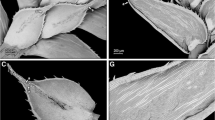Abstract
Senecio galicianus var.manantlanensis (sectionPalmatinervii) occurs in cooler, moister habitats at higher elevations of the Sierra de Manantlán than the typical variety. Morphological, ecological, and phenological data support maintainingS. galicianus andS. Kerberi as species separate from the closely relatedS. Roldana and treating the new taxon as a variety ofS. galicianus. Although var.manantlanensis tends to have larger and less deeply and sharply lobed leaves than var.galicianus,t-tests and discriminant analyses demonstrate that the best diagnostic characters are the fewer but longer phyllaries and florets in its heads.
Similar content being viewed by others
Literature Cited
Barkley, T. M. 1985. Generic boundaries in the Senecioneae. Taxon 34: 17–21.
Cronquist, A. 1988. The evolution and classification of flowering plants. Ed. 2. New York Botanical Garden, Bronx, NY.
Gibson, E. S. 1969. A revision of the sectionPalmatinervii of the genusSenecio (Compositae) and its allies. Ph.D. dissertation. Kansas State University. Available from: University Microfilms, Ann Arbor, MI; publ. no. 70-4613.
Holmgren, P. K., W. Keuken & E. K. Schofield, 1981. Index herbariorum. Part I: the herbaria of the world. 7th ed. Regnum Veg. 106.
Iltis, H. H., J. F. Doebley, R. Guzman M. & B. Pazy. 1979.Zea diploperennis (Gramineae): a new teosinte from Mexico. Science 203: 186–188.
Kowal, R. R., M. J. Lechowicz & M. S. Adams. 1976. The use of canonical analysis to compare response curves in physiological ecology. Flora 165: 29–46.
McVaugh, R. 1972. Compositarum Mexicanarum pugillus. Contr. Univ. Michiaan Herb. 9: 359–484.
— 1984. Flora Novo-Galiciana. Vol. 12: Compositae. Univ. of Michigan Press, Ann Arbor.
Morrison, D. F. 1967. Multivariate statistical methods. McGraw-Hill, NY.
Robinson, H. & R. D. Brettell. 1974. Studies in the Senecioneae (Asteraceae). V. The generaPsacaliopsis, Barkleyanthus, Telanthophora andRoldana. Phytologia 27: 402–439.
Rzedowski, J. & G. C. de Rzedowski. 1985. Flora fanerogamica del Valle de Mexico. Vol. 2: Dicotyledoneae (Euphorbiaceae—Compositae). Instituto de Ecologia, Mexico, D. F.
Steel, R. G. D. & J. H. Torrie. 1960. Principles and procedures of statistics. McGraw-Hill, NY.
Author information
Authors and Affiliations
Rights and permissions
About this article
Cite this article
Kowal, R.R. A new variety of Senecio (Asteraceae: Senecioneae) from the Sierra de Manantlán, Jalisco, Mexico, with notes on the S. roldana complex. Brittonia 43, 102–115 (1991). https://doi.org/10.2307/2807303
Issue Date:
DOI: https://doi.org/10.2307/2807303




